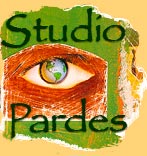
The Studio Process
The Virtual Studio
History of Studio Pardes
Why "Pardes"?
THE MEANING OF "PARDES"
My work has long included exploration of Jewish themes, images and ideas. Pardes, originally an Aramaic word, in Hebrew means orchard or garden. In the Jewish mystical tradition it refers to the Garden of Eden. I converted to Judaism in 1979 and finally found my way to a tradition where "God wrestling," to quote Rabbi Arthur Waskow, is a much loved way to remain spiritually fit. When I decided to open a studio in Oak Park, the name "Studio Pardes" kept coming into my mind, my witness writings and even my dreams. I resisted at first, thinking the word too obscure, too particular to Judaism, a bit grandiose, and too 'spiritual' after the no-nonsense name 'Open Studio Project'. But the name persisted and I accepted it. I do see the studio as a place where, during the moments of creation, we become replenished, time stops and perfection enfolds us.
In my studies of Kabbalah I learned more about the word pardes that exemplifies the rich layers of meaning that Judaism is always inviting us to plumb. The letters of the word pardes refer to the four levels of meaning available when one studies a text: the consonants P-R-D-S, in Hebrew called peh, resh, dalet and samekh (Hebrew is written without vowels).

Traditionally, Torah is studied on four different levels: p'shat, a simple, literal reading, remez, the level of associations and metaphor or what is hinted at in the text, drosh, the level where other materials or texts are brought in as commentary to illuminate the story, and sod, the level of the secret held in the material (Cooper, 1997). One rabbi said that sod is the story as if God whispered it in your ear.
I realized that there are also four levels by which to approach the image when writing a witness to it. In the Studio Process p'shat refers to description, what do you see in front of you in the simplest terms? Just letting yourself see color, shape and space without naming it beyond those attributes. Remez, we begin to listen for tentative names, emotional aspects, personal associations, metaphors and we begin to dialogue with the image. We try to stay open to multiple meanings and come to no conclusions. To work on the level of drosh we continue to engage in our dialogue so that the image tells us its own story but we may also consult a dictionary, symbol book or other references material to deepen our understanding and see what other contexts or cultures can add to our understanding. Some images deliver us to the level of sod, where we experience the "AHA!" when the pieces of information form a sort of lightening bolt that pierces our awareness or our heart, illuminating a new truth, giving us the answer to the query posed in our intention perhaps or redefining a concern or problem in a new way.
I struggled for a long time to come to peace with the fact that although I love Judaism and I respect and admire other religious traditions, symbols of many have appeared in my work such as Kali, Kwan Yin, Jesus as well as women in purdah, shamans and mendicant monks, I am, finally, a transdenominational soul who, through art and writing, travels to the place where all truths and traditions exist in peace and harmony, the place of which Rumi says:" Beyond right and wrong there is a field, I'll meet you there". This is what Pardes is, not a physical place, but a state of being. The Studio Process, alone or with others, creates a path to the field. Try it, I'll meet you there.
References:
Cooper, D. (1997) God is a verb. New York: Riverhead Books.
Waskow, A. ( ). Godwrestling.
Home | Introduction | Site Map | Pat Allen Bio | Pat Allen CV
Studio Pardes | Process | Virtual Studio | History | "Pardes"
Writings | Books | Essays | Blog | Writings about Pat Allen
Gallery | Portfolio | Collaborative Projects | Community Projects
Workshops & Classes | Links | Contact Pat Allen
